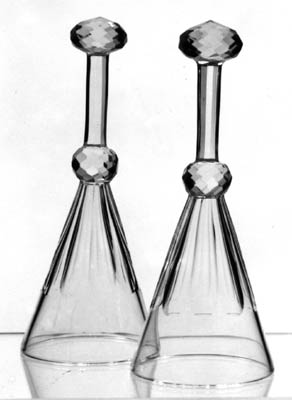
(The primary source for information in this file is Douglas Ash's survey "Glasses that Have No Feet" which appeared in the January 1968 issue of Antique Dealers and Collectors' Guide, pp. 52-55. The Rakow Library of the Corning Museum of Glass kindly provided the writer with a photocopy of this comprehensive and informative article.)
Unstable glass vessels lacking proper feet fall into two main categories: ordinary drinking vessels which were designed in accordance with a contemporary convention but for no other apparent reason, and vessels devised for specific circumstances in which stability was of no consequence (Ash, p. 52).The first category includes claw beakers and cone beakers, those ancient drinking vessels of Anglo-Saxon origin (fifth and sixth centuries). Ash postulates that they were used "when it would not have been appropriate ... for the drinker to linger over his tipple", citing the Saxon custom of bringing a newly-arrived guest a cup of ale, mead, or wine. A more recent "contemporary convention" might be the so-called bottoms-up glasses that were a popular fad during the 1930s and 1940s (Avila 1978). Often of conical shape, they were set "upside-down" on a tray, together with a decanter or mixer, for the serving of sherry or cocktails. Stylishly designed in Deco-Moderne taste, with only a knob for a stem, they probably can be found in today's retro-shops.
In the second category, where "stability was of no consequence", there are two types of footless stemware -- coaching glasses and stirrup glasses. The former were used to provide refreshment to travellers in stage coaches while the coaches' horses were being changed. This usually took only a few minutes.
On halts of such short duration, visits to the bar of the inn were out of the question, so if the inn-keeper wished to do any business, refreshment had to be taken out to the coach. It may be assumed that the use of glasses without feet in this connection arose through costly experience: inside passengers had probably tended to put their glasses on the floor among all the feet, while outside passengers had no doubt tried to stand them on various parts of the roof. Casualties among inn glasses must have been tiresomely frequent, but footless coaching glasses had of necessity to be retained in the hand. When halts were abbreviated to the limit in the interests of speed, passengers would have had no time to do anything but pay for a drink, swallow it, and hand the glass back, and in these circumstances footless coaching glasses were entirely satisfactory (Ash, p. 54).
The second type of drinking glass appeared at animal hunts as early as the early eighteenth century when it was necessary to serve liquor to a horseman in the saddle. Except for their footless construction such "stirrup cups" or glasses echo the style of the day in their bowl shapes and decorations. Early examples "display a rather clumsy robustness entirely in keeping with a boots-and-spurs context". Later examples, illustrated here by a pair of glasses, have a classic elegance that would be at home in the finest drawing room.
A pair of cut-glass stirrup glasses. Colorless, lead glass. England, c1820 or slightly earlier. Taken from an original set of twelve matching glasses sold by the auction company Tennant's (UK), acting for the owners of Newby Hall, near Ripon, North Yorkshire. The contents of the hall "not required for the public or private Rooms" were sold "on the premises" 1-4 Jul 1985. H = 7" (17.8 cm). Sold for $350 each in 1988.

Although stirrup glasses were undoubtedly brought out-of-doors by a servant bearing a tray and decanter, they had to be stored somewhere indoors between "lawn meets". For this purpose a specially constructed table was sometimes used. Ash (p. 55) describes and illustrates one which consists of a central stretcher and "side rails, which pull out to disclose six holes on each side to accomodate the stems of the glasses". The glasses would hang by their bowls. Perhaps this was the storage arrangement for the Newby Hall glasses for they have no wear on their rims.
It is not known whether stirrup glasses were ever used, much less made, in the United States. In fact, the extent of fox hunting in this country early in the nineteenth century is poorly documented. The hunt clubs that continue the sport today were not founded until the 1870s and 1880s by which time the use of such glasses had gone out of fashion. Stirrup cups made in material more durable than glass were popular, and they are the type usually found today. Those in silver, particularly those with molded fox heads by well-known silversmiths, are especially sought by collectors.
The appearance of English glass of the early nineteenth century -- and even earlier -- in American antique shops occurs more frequently than commonly thought. In the case of the Newby Hall glasses an American antiques dealer, visiting abroad, purchased them from the dealer who had acquired them at the Tennant auction in 1985. The American then placed them on sale in an antiques mall in the Hudson River Valley (NY) where the writer was fortunate enough to find them.
The assistance of Eileen M. Collins, New York City, and David R. Strain Antiques, Tynemouth, England is gratefully acknowledged.
Updated 19 Jul 2002